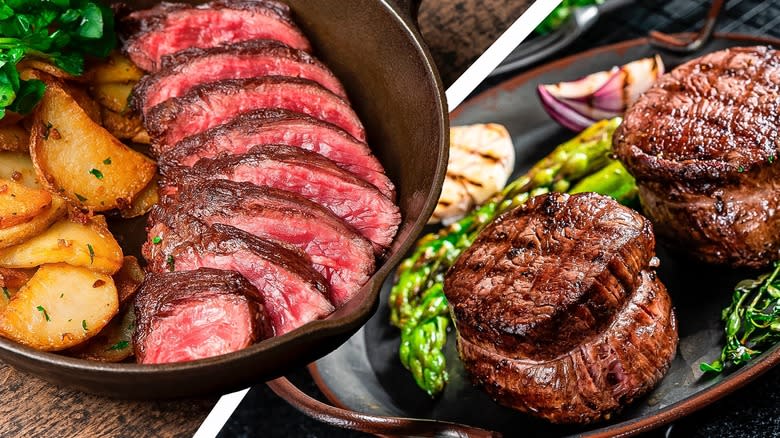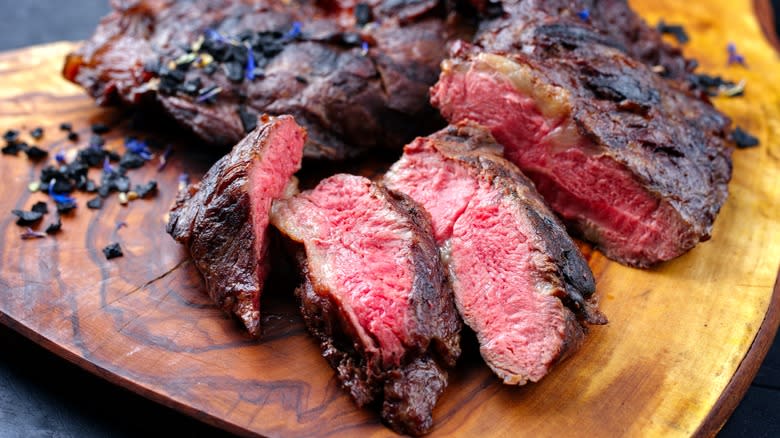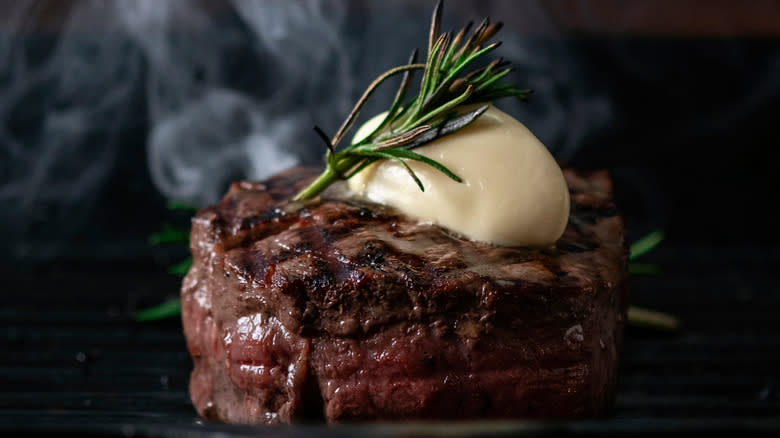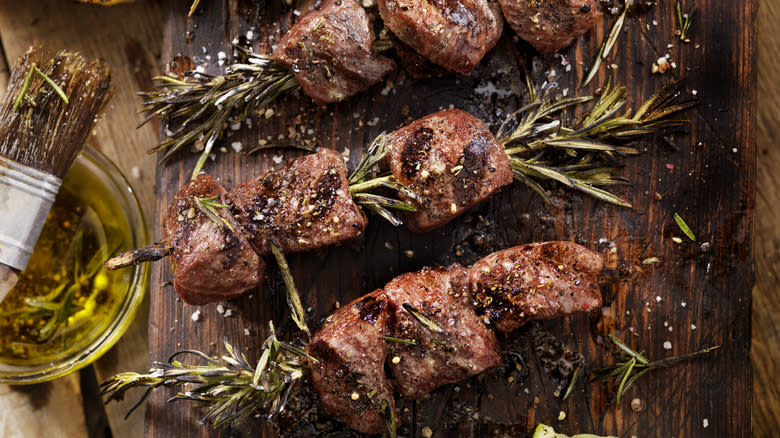The Difference Between Bistro Steak And Filet Mignon

When it comes to showcasing the flavor of beef, there are few better vessels than a tasty steak. Especially when utilizing a delicious cut, it only takes a few minutes of high-heat cooking to create a beautiful result.
Small easy-to-cook prized cuts like the filet mignon offer an incredibly delicate and delicious dose of flavor, all in under a 10-ounce size. It may seem that with a smaller portion comes a steeper price. However, that's not always true. For another tender, petite, and more affordable option, turn to the bistro steak. This small cut comes from a tender area -- just like the filet mignon -- but is sourced from a different section of the cow. While infrequently available because it requires a skilled butcher to cut it, it's a delicious and malleable alternative to its more lavish cousin. Nevertheless, the two steaks do have a few differences in flavor, composition, and how best to cook them.
Read more: Your Guide To The Different Cuts Of Steak
What Is A Bistro Steak?

The small bistro steak hails from the chuck section (upper shoulder) of the cow, cut in an elongated shape reminiscent of a tenderloin. The meat is also referred to as butcher's steak or shoulder tenderloin. It contains a generous portion of fat, which is well-marbled throughout the steak. It's matched with a strong beef flavor, and the meat will retain moisture in a variety of cooking methods, whether it's grilled, roasted, or sauteed.
Although these factors combine to make this a delicious piece of meat, bistro steak is a relatively rare cut. Since it's not included in common butchering practices, the steak doesn't make an appearance in most counters. It can only be found in select stores and is sometimes available on request. Additionally, this steak typically comes in smaller sizes, around half a pound, a characteristic similar to filet mignon, making it perfect for cooking at home. So, it's well worth tracking down a supplier of bistro steak for a section of beef that's both forgiving to prepare and brimming with flavor.
What Is Filet Mignon?

The prized ultra-tender filet mignon comes from the tenderloin, towards the back of the cow rather than the shoulder. The best filet mignons are sourced from the narrowest section of the tenderloin. Each steak is a sliced cross-section of the cut, also around half a pound in size. Since this delicious cut encompasses only around 3% of the entire cow, it garners a high price.
Its beloved melt-in-the-mouth texture stems from the animal's anatomy. Although the filet mignon is a muscle without much marbling, it goes through very little movement. As a result, the meat is buttery in texture leading to a delicious bite of meat. The steak can be seared, grilled, or broiled; however, regardless of the method, it's best cooked to medium rare. Plus, with its generous two-inch thickness, filet mignon develops a delectable crust, while staying soft in the middle. Its aesthetically pleasing round shape makes it easy to plate, whether with a side or as part of a surf and turf.
Bistro Steak's Beefy Flavor Enjoys Bold Additions

Since bistro steak and filet mignon are derived from different beef sections, they take on distinct flavor palates. As a part of the chuck, bistro steak has a rich, meat-forward taste. As a result, the cut holds up to bolder accompaniments, like fresh aromatic chimichurri, spicy Asian-style sauce with chili and garlic, or an umami-rich mushroom sauce. It's served either whole or sliced, with a sauce poured over. Alternatively, it can be thinly sliced to make delicious beef fajitas.
On the other hand, filet mignon has a more nuanced flavor due to its lean, less fat-forward composition. A perfectly prepared filet mignon only needs a gentle seasoning of salt and pepper so as not to override its flavor. Due to its leaner content, it does well with additional fat, like bacon wrapping or butter dolloped on top during preparation. It's almost always served as a whole steak, with simple sides, rather than coated with a strong sauce or mixed into a dish.
Bistro Steak Can Handle More Varied Cooking Methods

Filet mignon's steeper price and more tender consistency render it best reserved for simple preparation methods. To not overcook, employ classic steak techniques, like being seared in a cast-iron pan, a reverse sear, or grilling. For a dependably perfect interior, the sous-vide method is another good option. Regardless of the method, it's a cut best not overcomplicated -- its incredible texture and flavor hold up on their own.
Conversely, the beefier bistro steak has a more rigid consistency that works with other cooking styles. It can hold up through a slow roasting, or be infused with additional flavor in a smoker. The flavor blooms over hot charcoals, or the grill top can be covered, and the steak cooked on indirect heat. Infused with a fragrant marinade, this cut can even exhibit terrific flavor as a kebab or in a stir fry. Just make sure to keep an eye on the internal temperature; overcooking is still the principal pitfall.
Read the original article on Tasting Table.

